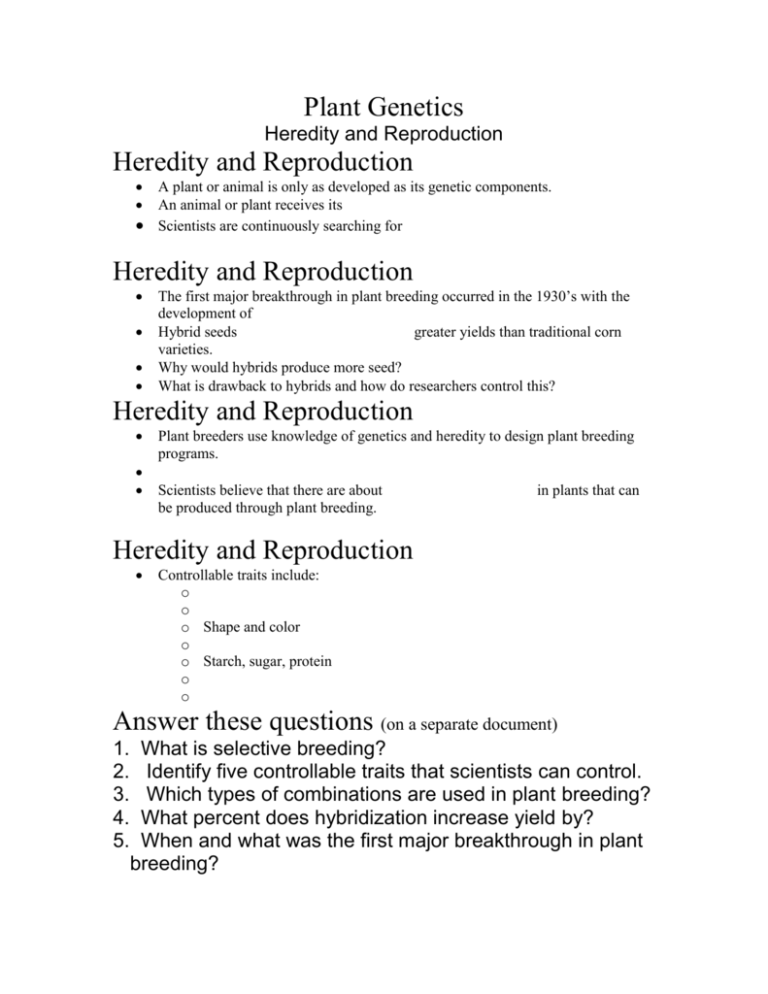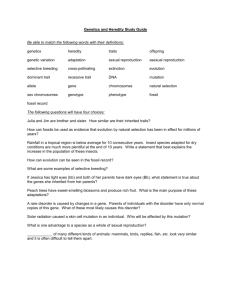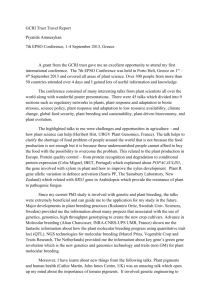Plant Genetics
advertisement

Plant Genetics Heredity and Reproduction Heredity and Reproduction A plant or animal is only as developed as its genetic components. An animal or plant receives its Scientists are continuously searching for Heredity and Reproduction The first major breakthrough in plant breeding occurred in the 1930’s with the development of Hybrid seeds greater yields than traditional corn varieties. Why would hybrids produce more seed? What is drawback to hybrids and how do researchers control this? Heredity and Reproduction Plant breeders use knowledge of genetics and heredity to design plant breeding programs. Scientists believe that there are about be produced through plant breeding. in plants that can Heredity and Reproduction Controllable traits include: o o o Shape and color o o Starch, sugar, protein o o Answer these questions (on a separate document) 1. 2. 3. 4. 5. What is selective breeding? Identify five controllable traits that scientists can control. Which types of combinations are used in plant breeding? What percent does hybridization increase yield by? When and what was the first major breakthrough in plant breeding? Flowering and Pollination Two major plant classifications are the These include flowering plants, grasses, and cereals. All angiosperms develop flowers which contain that are enclosed in an The flower is the for the angiosperms. A flower is complete if it has all four of the following structures: o An lacks one or more of the before mentioned structures. A flower that has both (male reproductive tissues) and a (female reproductive tissues) is a perfect flower. Imperfect flowers have either stamens or a carpel, but not both. Answer These Questions (on a separate document) 1. Identify the two major classifications of plants. 2. The flower is the ____________ of the angiosperms. 3. A complete flower has four structures, identify them. 4. A flower which has both male and female is tissues is which type of flower? 5. If a flower has either stamen or a carpel, which type of flower is this? Flowering and Pollination The sepals and petals help An incomplete flower is one which has no Most cereal and grass plants have incomplete flowers, Flowering is initiated by: o o o Morphological maturity (able to produce seed) The majority of food-producing plants induce flowering without external stimulation. The Stamen consists of the Anthers and their supporting their supporting filament. As the Anther matures, The Carpel includes the Stigma, Style, and Ovary. The Stigma is the swollen end of the Style, Answer these questions (on the separate document) 1. What does the Carpel include? 2. Where does the development of the pollen grain occur? 3. What is the photoperiodism? 4. What is meant by morphological maturity? 5. A flower which has no sepals or petals is which type of flower. Flowering and Pollination Self-pollination occurs when o o Cross-pollination involves Some plants are and produce fruit and seed without the transfer of pollen from another cultivar. o Most monocot plants. A plant is considered if it requires pollen from another plant in order to set fruit. o Sterility is due to the protein composition of the cell of wall of pollen grains. o The protein sends a signal to the stigma indicating Each pollen grain contains a When the pollen lands on the stigma, . The pollen tube enters the nucleus of the ovule by passing through the Micropyle The generative cell has produced One gamete unites with the egg cell to form the Zygote, The other male gamete to form the endosperm. The endosperm is the seeds food reserve for germination. The time between pollination and fertilization in most angiosperms is Once fertilization has occurred, Answer These Questions (on the separate document) 1. What is the time between pollination and fertilization. 2. How many male gametes are produced through mitosis? 3. What is the function of the gametes? 4. Pollen enters the nucleus by passing through what opening? 5. What causes sterility. Genetics and Heredity Chromosomes contain They transmit the information to offspring. Each plant species has the in all vegetative cells. Chromosomes are long, thread-like structures consisting of Genes: The gene is the heredity unit of a plant. Answer these questions (on the separate document) 1. Why do vegetative and reproductive cells have varying numbers of chromosomes? 2. Which type of material do chromosomes contain? 3. What does DNA stand for? 4. What does RNA stand for? 5. What is a gene? Genetics and Heredity These are called Homologous Chromosomes. They have the affecting the and are located at the along the chromosomes. Matching genes on Homologous Chromosomes are called Gene alleles always occur on the same Locus (location) along the pair of chromosomes. Allelic genes can be A dominant gene causes a A recessive gene causes the character to be Dominant genes are represented by Recessive genes are represented by Meiosis controls the formation of egg and sperm cells. As gametes are formed, They segregate randomly so that each gamete receives one allele or the other. The allele composition of a plant is the A common method of predicting the genotypes and phenotypes of offspring is the Answer these questions (on the separate document) 1. A common method for determining phenotypes and genotypes is the? 2. The allele composition of a plant is known as the? 3. What is a homologous chromosome? 4. Meiosis controls formation of which two sex cells? 5. Allelic chromosomes can be of two types, identify them. Plant Breeding Plant Breeding: A basic type of plant breeding is Selection is when Hybridization: Crossbreeding usually produces a plant that is Hybrids do not pass many of their traits to their offspring, so parent stocks must be crossed each year to produce new seed. The production of hybrid seed is managed by Growers are under contract to grow the parent lines and make the hybrids. Seed production fields must be isolated from other fields to prevent When tassels begin to emerge, the female plants are detassled to prevent The wind then cross-pollinates the male parent with the female to produce hybrid seed. Inbreeding: Backcrossing: Biotechnology Techniques Biotechnology: Biotech uses molecular biology and molecular genetics for developing plant breeding methods. These include: tissue culture, protoplast fusion, embryo manipulation, recombinant DNA. Micropropagation: Cell culture: Microinjection: Cell walls can be dissolved using enzymes. o This exposes the cells protoplast. o This allows the genetic makeup of different plants to be Recombinant DNA or genetic engineering involve; 1. 2. 3. Transgenic organisms would carry in their cells a foreign gene. 1. Starts with cutting gene with an enzyme. 2. The sliced gene is then 3. An enzyme is used to seal the spliced ends. 4. The DNA plasmid is inserted into 5. The result is a Answer these Questions 1. What three items does genetic engineering include? 2. What is micro-injection? 3. What is cell culture? 4. What is biotechnology? 5. Describe the process of gene splicing?







